Purple is not a common color you would expect to find on a spider. The Purple Tree Tarantula and the Antilles Pinktoe Tarantula. Both of these are very popular in the pet trade.
Table of Contents
Are There Purple Spiders?
In short, yes there are purple spiders, but they are very few and far between. We have compiled a list of the 19 types of purple spiders in the world.
Types of Purple Spiders
1. Purple Tree Tarantula

Scientific name: Avicularia purpurea.
Common name: purple tree tarantula, Ecuadorian purple tarantula, Ecuador purple pinktoe.
The purple tree tarantula comes from Ecuador and is often called the Ecuador purple pinktoe. They live in a variety of habits and are often encountered in agricultural areas with grazing cattle. They have also been found in the walls of buildings and spaces below the roof.
These tarantulas can grow to 13cm in leg span as adults. They are an intense purple-blue during the daylight. Their belly is velvet black with urticating hairs, which cause skin irritation if the spider throws them at you.
The purple tree tarantula is an arboreal spider that builds a nest in the tree hollows.
2. Martinique Pinktoe
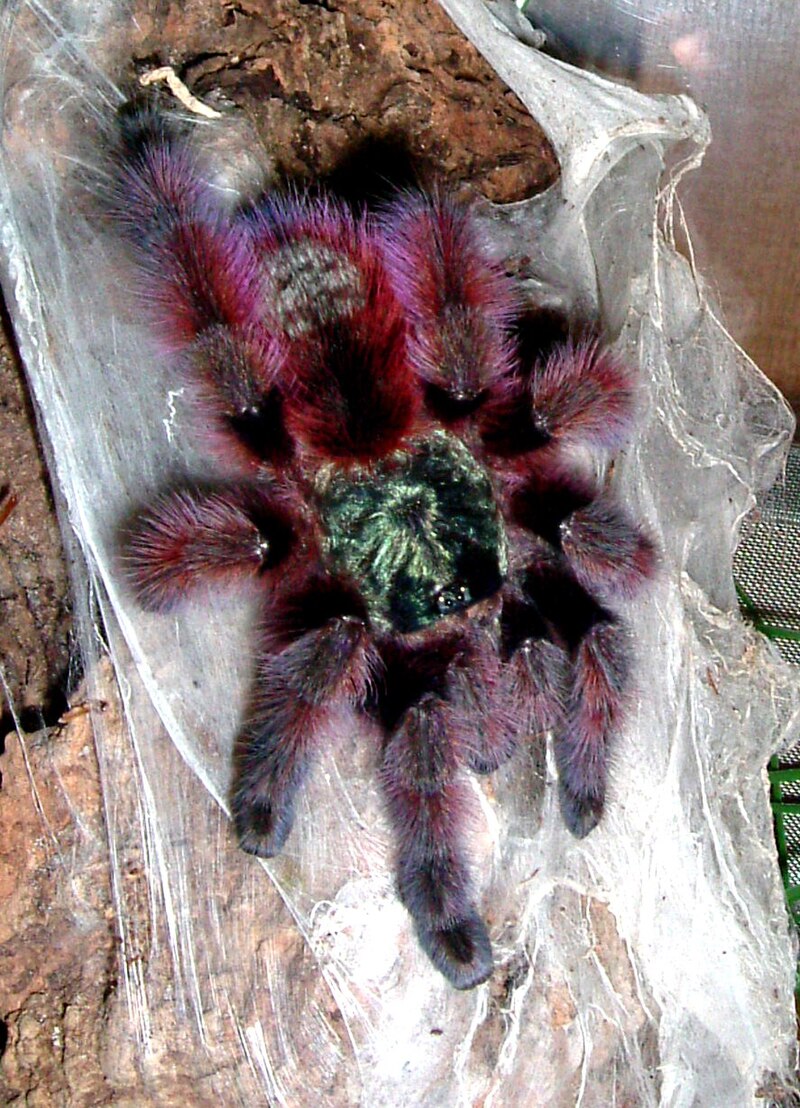
Scientific name: Caribena versicolor.
Common name: Martinique red tree spider, Martinique pinktoe.
The Antilles pinktoe tarantula is also known as the Martinique pinktoe or Martinique red tree spider. They are docile spiders with beautiful coloration. These are tree-dwelling tarantulas that build funnel webs, where they spend the majority of their time.
Spiderlings are bright blue and as they grow their abdomen turns red, their legs green with pink tarsi and purple hairs. Males are brighter in color than females, they are also smaller.
This tarantula grows to 15cm in leg span and is a New World tarantula, which is bold, cheeky, and harmless to humans.
3. Madagascar Hermit Spider
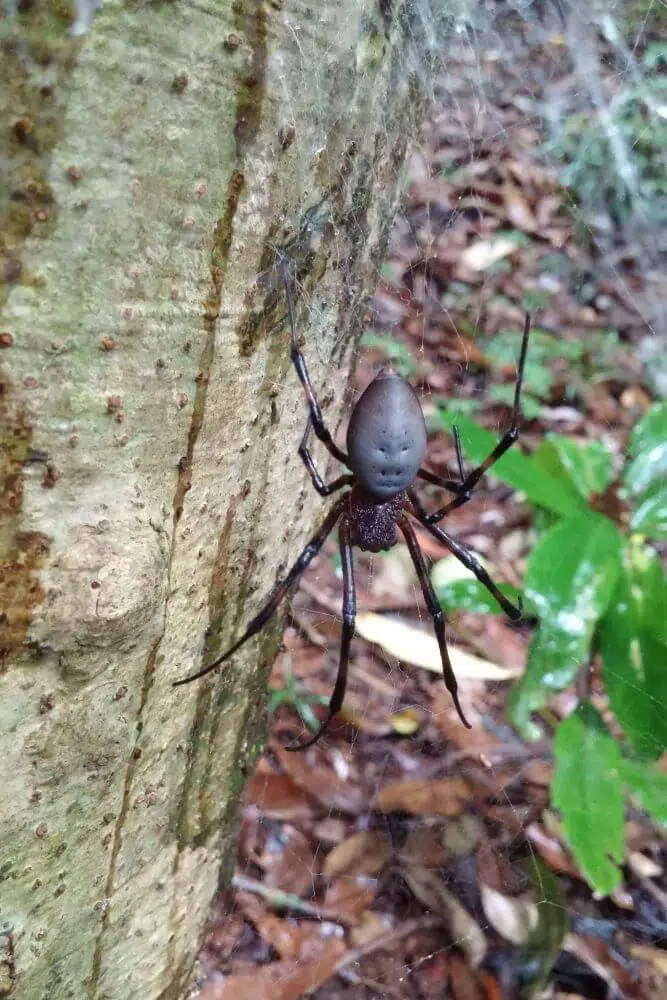
Scientific name: Nephilingis livida.
Common name: Madagascar Hermit Spider.
The Madagascar hermit spider comes from Madagascar and the nearby Islands. The female color ranges from cream to brown, purple to blue, and usually dark brown. Females grow to 24mm in body length.
Males grow to 5mm in body length and are gray with white dots. They are common visitors to Madagascan homes. They eat pests, including mosquitoes and flies, and are considered beneficial spiders. Their mouths are too small to pierce human skin.
4. Sphodros abboti
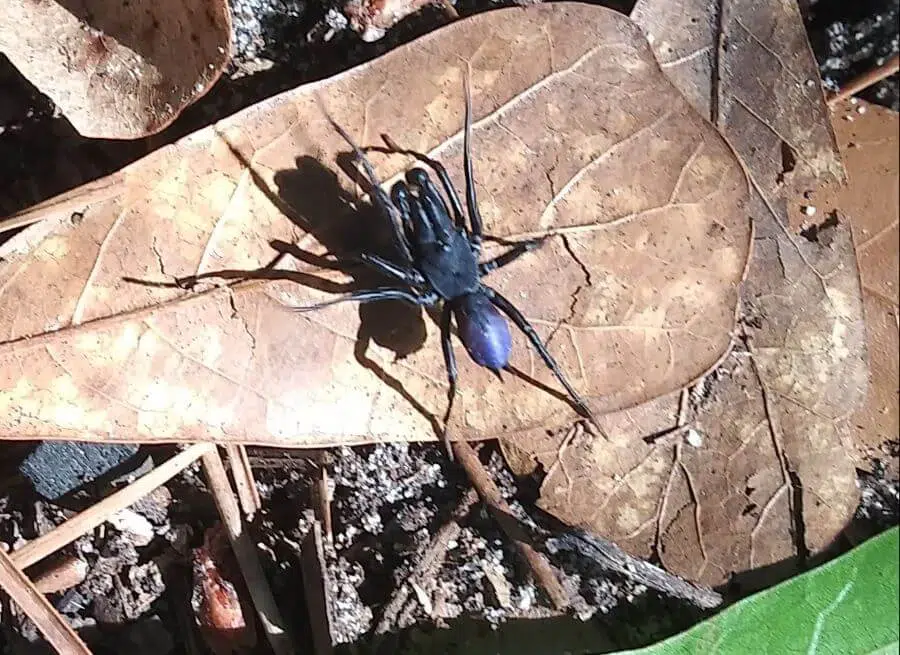
Scientific name: Sphodros abboti.
Common name: purseweb spider.
The Purseweb spider belongs to the Atypidae family and was first described in 1835. This spider is endemic to Florida in the United States.
These black spiders have a purple back, while males have a blue abdomen, which is used to attract females. They create webs in the middle of trees.
They have large fangs and while not harmful to humans, they will give a painful bite if provoked.
5. Chrysilla volupe

The Chrysilla volupe is a jumping spider that is found in Sri Lanka, India, Bhutan, and Nepal. Males are red to orange in color with two blue stripes and golden to purple shaded legs. Females are gray with yellow legs.
These spiders can grow to 5.4mm including their legs. They are not dangerous to humans.
6. Purple-Gold Jumping Spider (Simaetha sp.)
The purple-gold jumping spider is a newly discovered species in the Sraburi Province in Thailand. These are small and wickedly fast jumping spiders and are one of the most beautiful jumping spiders.
They are only 4mm in length and have a base color of purple with golden borders. As with other jumping spiders, they are harmless to humans and are curious and fast jumpers. These spiders can jump more than four times their body size when ambushing prey or escaping predators.
7. Phormictopus sp.

This is a tarantula found in Cuba and Hispaniola with some species in Brazil and Argentina. They are large spiders growing to 73mm in body length and urticating hairs. The hairs are kicked in the direction of any threats and can cause skin irritation in humans.
Females are a metallic bronze color, while the males are gorgeous purple. They are defensive spiders with slings being skittish and fast. As they age and get bolder, they will try and flee. Don’t be surprise if you provoke them and get a bite or hairs thrown at you.
8. Crab spiders
Scientists have documented that certain crab spider species can change their color based on the flowers where they live. These spiders tend to remain in the same flowers, hanging out and stalking prey.
These spiders eat unwanted pests and pollinators and are a very important part of the food chain. Their color change is not as fast as a chameleon can take anywhere from two to twenty-one days for a full-color change to take place.
As with all other crab spiders, they are venomous. Their mouths are too small to pierce human skin, therefore they are not considered dangerous to humans.
9. Purple Jumping Spider
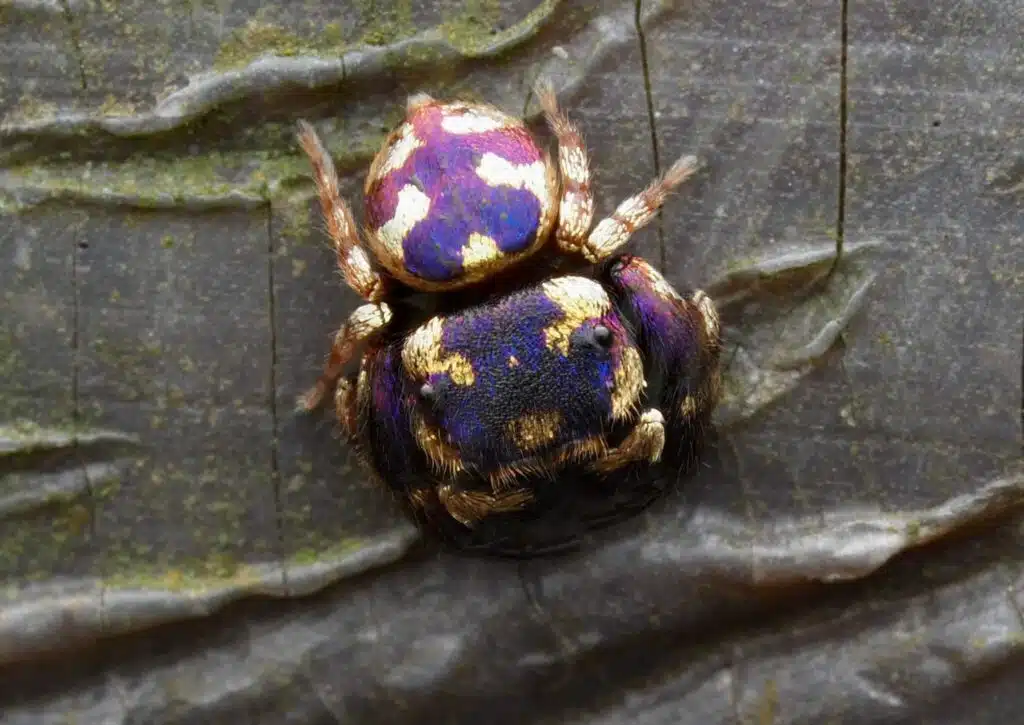
Scientific name: Irura bidenticulate
Common name: Purple Jumping Spider
Growing to a size of just over 0.2 inches, Purple Jumping Spiders are a recent discovery.
Native to East and Southeast Asia, this spider species is known for having males with purple nuances.
A mostly purple cephalothorax and abdomen are spotted on these tiny male spiders. These vivid colors are then coupled with gold patterns across the body.
Females lack the vivid purple nuances of males as they’re almost entirely golden yellow.
The golden female Purple Jumping Spider features black patterns on the dorsum and on the head. Females also have golden and yellow legs.
Purple jumping spiders have 4 eyes arranged in a row with the central ones being larger.
This species should not be confused with The Marbled Purple Jumping Spider (Phidippus purpuratus), which is also purple.
10. Elegant Golden Jumping Spider
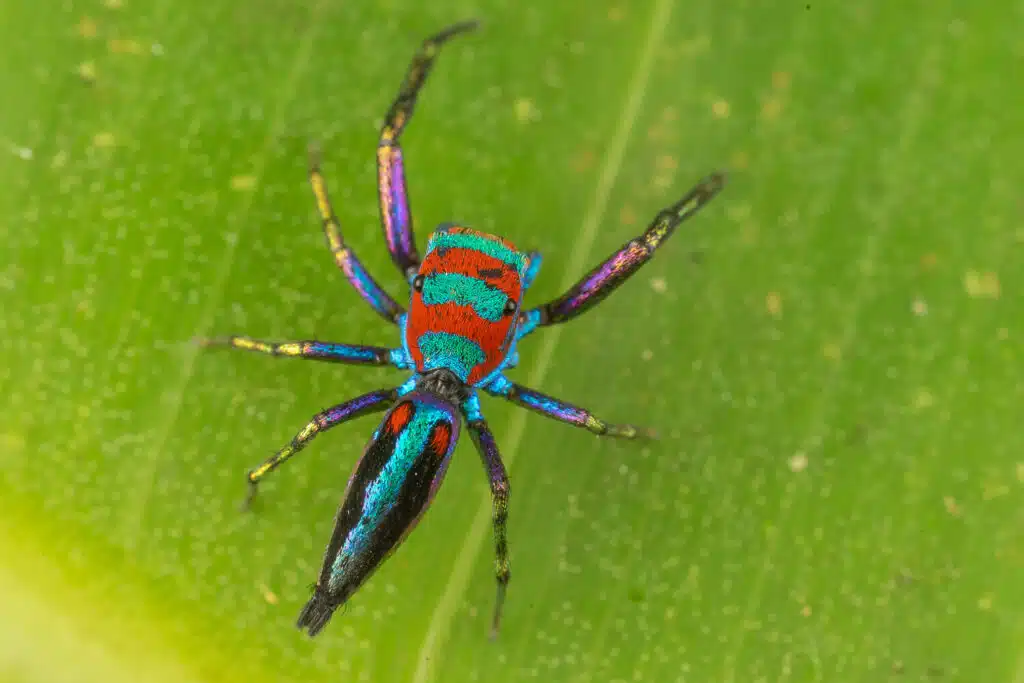
Scientific name: Chrysilla lauta
Common name: Elegant Golden Jumping Spider
There are some spider species where males and females have different coloring and even different sizes.
Even more, there are some species, such as The Elegant Golden Jumping Spider where males and females even have a different shape.
If the male has an elongated slim body shape and blue nuances, female Elegant Golden Jumping Spiders are wider, and mostly purple and gold.
The abdomen has a purple-blue nuance, as does the thorax. Red overlays are seen across the body of the female.
Male Elegant Golden Jumping spiders mostly have purple nuances across the legs while the legs of the female have a pale yellow color.
Slight iridescence is also seen on males while female spiders tend to be a bit more dull colored.
11. Unusual Peacock Spider
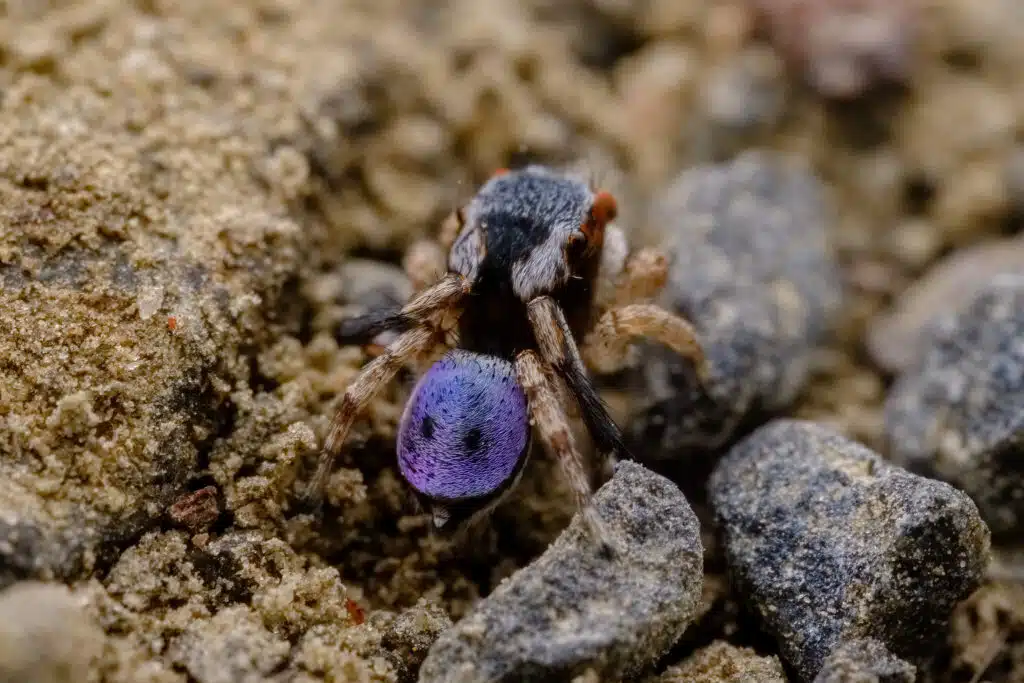
Scientific name: Maratus anomalus
Common name: Unusual Peacock Spider
Some of the most colorful spiders in the world are peacock spiders. This Australian species is even known as an unusual or an atypical species due to its varying colors.
It shows different colors depending on where you see it from, the angle, and the light conditions.
This is why a male can look mostly turquoise from one angle while it may look purple from another angle.
Its iridescent abdomen is what catches the attention of people.
This area of its body can also be green, gold, blue, and even black.
White and black colors are mostly specific to its cephalothorax.
A type of hairy spider, The Unusual Peacock Spider can even flick its colorful abdomen up as a communication tool when courting females.
12. Yellow-banded Pinktoe Tarantula

Scientific name: Avicularia juruensis
Common name: Yellow-banded Pinktoe Tarantula
The name of this species of tarantulas is inspired by the yellow bands across its legs.
A small hairy tarantula, Yellow-banded Pinktoe Tarantulas are native to South America and a rare species in captivity.
As an arboreal species, they need proper enclosure to thrive.
This species also comes in different colors, including a pink-purple morph. Even this colorful morph still comes with its best-known feature, the yellow bands across the legs.
13. Black Tunnelweb Spider

Scientific name: Porrhothele antipodiana
Common name: Black Tunnelweb Spider
A species of New Zealand and the small Chatham Islands, Black Tunnelweb Spiders are a distant relative of tarantulas.
These types of spiders are typically dark, often black or red-brown. They can also be dark purple to black, with purple covering their entire body.
Black Tunnerweb Spiders are among the most common species in New Zealand, which means even locals may spot them in the house or in the garden.
This large spider has a very painful bite, but its venom is not potent and is of any risk to humans.
Spotting this spider is mostly tied to spotting the female which lives considerably longer than males.
Females can live up to a few years while males mate and die.
14. Fringed Ornamental Tarantula
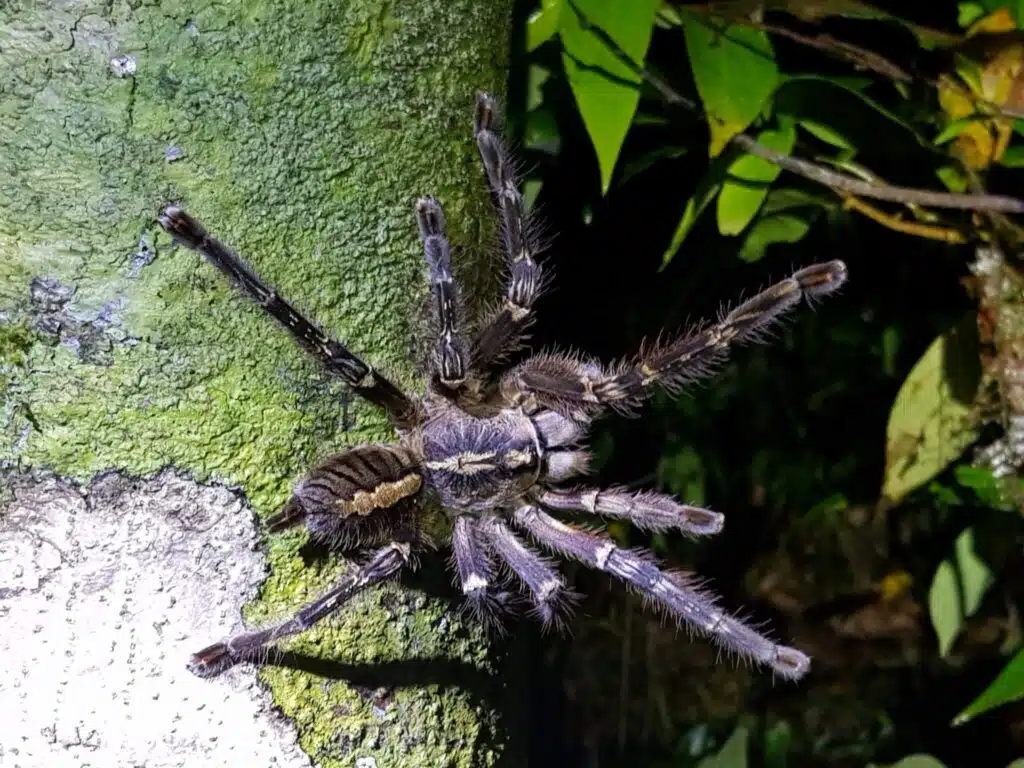
Scientific name: Poecilotheria ornata
Common name: Fringed Ornamental Tarantula, Ornate Tiger Spider
A species that’s mostly black with tan or light brown overlays, this type of tarantula also features a purple tinge.
This is a species that shows faint cephalothorax purple stripes and purple dots at the front of the head. Purple tinge abdomens with a colorful blue-purple stripe are also specific to these tarantulas.
A species with yellow or tan spots on its legs, Fringed Ornamental Tarantulas may also show a purple tinge on their legs.
A species native to Sri Lanka, Fringed Ornamental Tarantulas grow to an average size of around 10 inches.
Their large size and colorful appearance also make them a common pet. They are grown in separate enclosures for adults and juveniles.
Bugs are fed to these colorful tarantulas once or twice per week when grown in captivity.
15. Thick-spined Jumping Spider
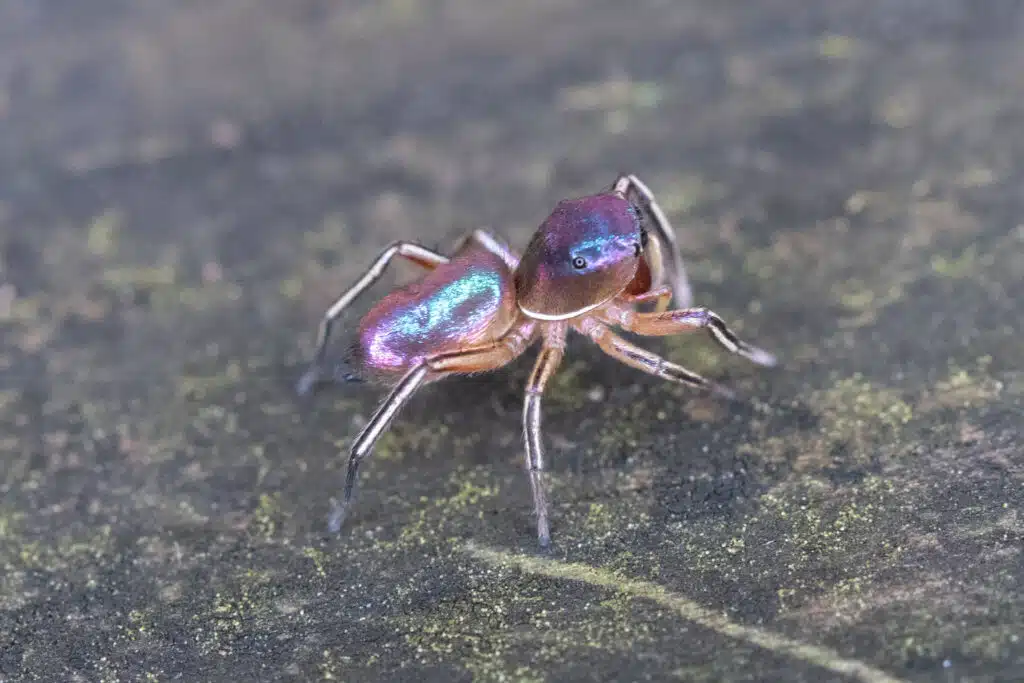
Scientific name: Tutelina similis
Common name: Thick-spined Jumping Spider
A purple and green nuance is a common morph of The Thick-spined Jumping Spider. This spider species is highly variable in coloring and also comes in a brown-purple morph.
Its most colorful morph shows a mostly green abdomen with purple margins. This is an iridescent color morph that allows for the species to shine in the sun.
Its cephalothorax also shows the same iridescent green color with purple margins.
The spider exhibits black legs or brown legs, depending on its morph.
While very colorful, The Thick-spined Jumping Spider is still small, growing to a size between 0.1 and 02. Inches.
Some of the rarest morphs of the species include an iridescent dark green dominant appearance.
Female Thick-spined Jumping spiders are slightly larger and may even live longer.
16. Salticus peckhamae
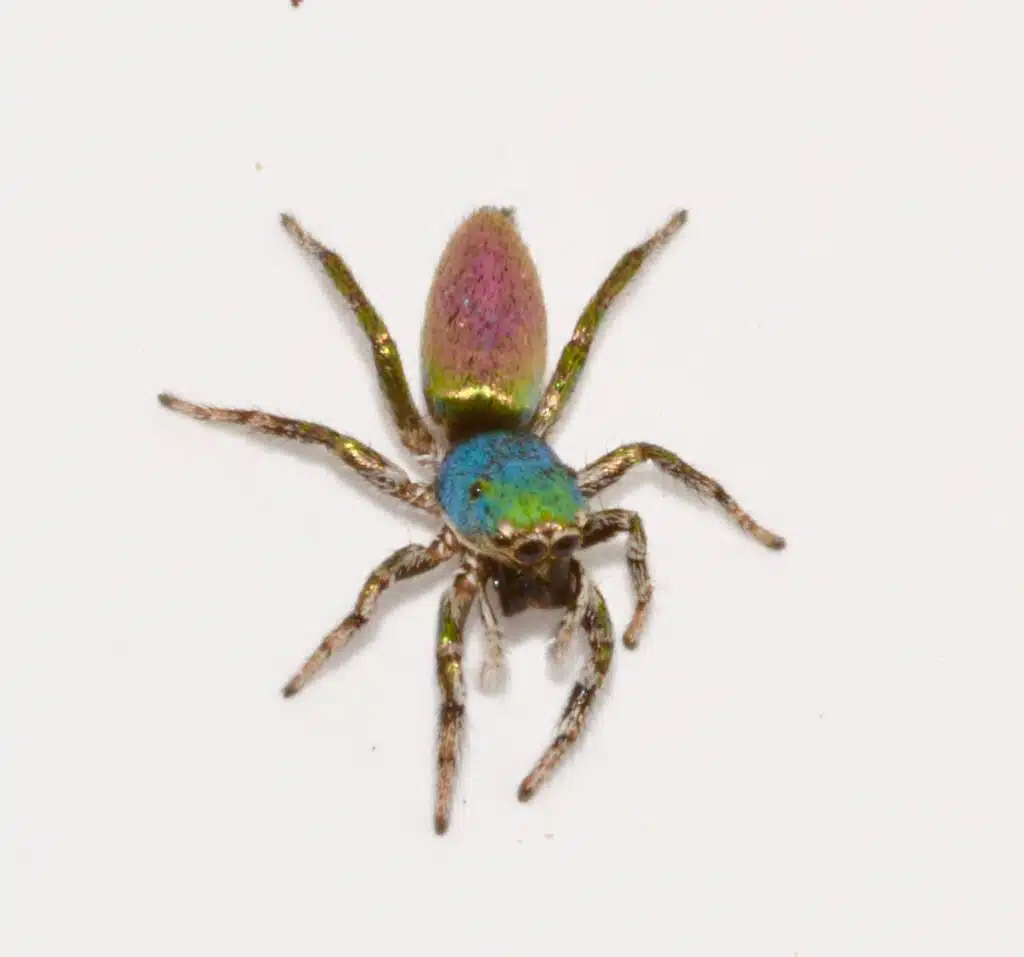
Scientific name: Salticus peckhamae
Native to the Southwestern United States, The Salticus peckhamae is a little-known purple spider.
It’s believed to be a short-lived species and also a limited-range spider.
Most importantly, it features a dominant purple nuance which immediately makes it stand out.
Its abdomen has a shiny purple nuance. The iridescent abdomen has bright gray-green margins and its color may even appear different depending on the angle.
The cephalothorax of the species is also partially purple, with more pronounced green margins or with wider margins compared to those on the abdomen.
Spiders of this genus have black and purple legs. The brightest purple areas on its body are those on the legs, followed by the purple abdomen, while the cephalothorax shows the darkest purple nuance.
This species moves by jumping and catching one by hand may not be easy.
17. Peacock Tarantula

Scientific name: Poecilotheria metallica
Common name: Peacock Tarantula
Peacock Tarantulas are some of the most colorful Asian tarantulas.
In fact, the species is mostly limited to a small area of Central India, where it immediately stands out in its green forests with its colorful appearance.
Tarantulas of this type have a vivid blue coloring. They show a blue dominant color across the legs and the body.
The juveniles of the species are purple, on the other hand.
A bright purple body is specific to the young Peacock Tarantula. This is a species with a pink-purple nuance with a contrasting white mid-dorsal stripe.
The legs of the juveniles are also purple closer to the body but they are mostly bright blue, resembling the legs of adults.
Bright and dark purple patterns start to fade from the thorax and abdomen of the juveniles as they turn blue and white into adulthood.
18. Coastal Peacock Spider
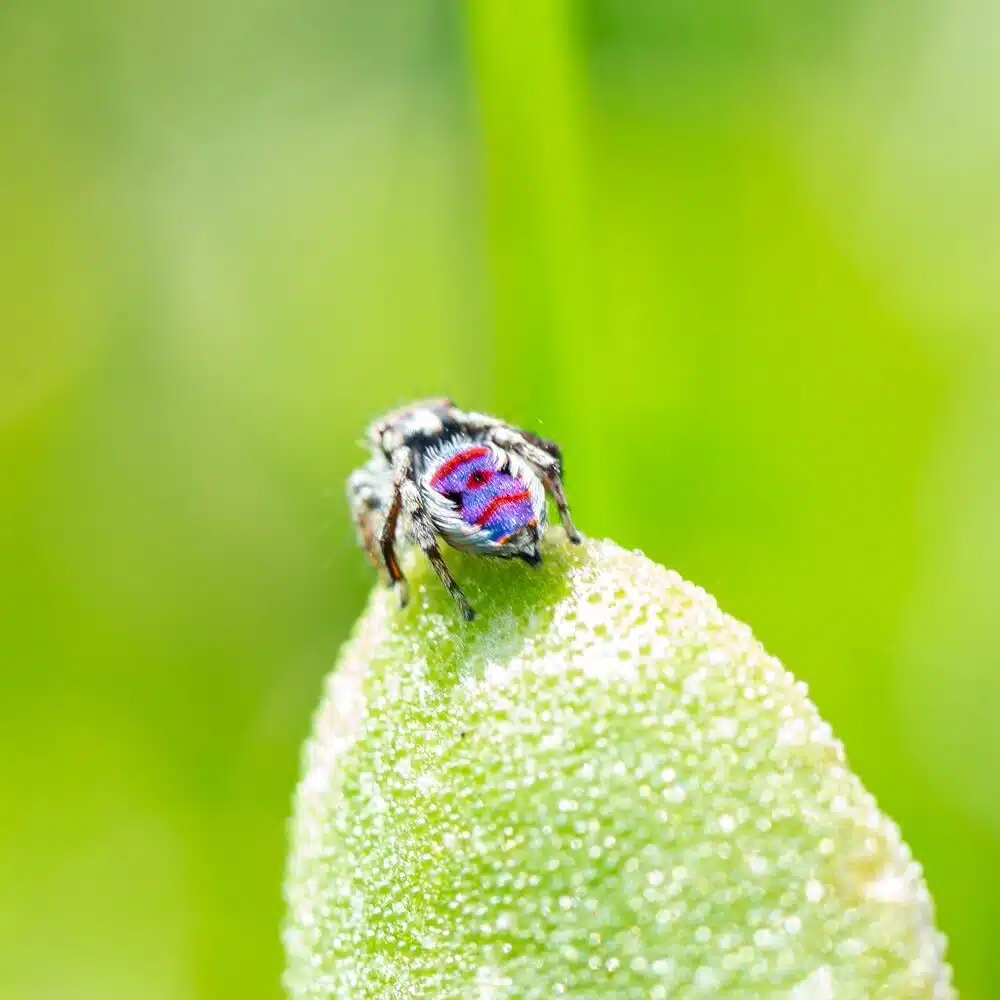
Scientific name: Maratus speciosus
Common name: Coastal Peacock Spider
There might not be many more intriguing and colorful spiders in Australia apart from peacock spiders.
This is a colorful species with an iridescent dancing abdomen that changes colors depending on where you view it from.
A base blue-purple color is specific to the abdomen which looks different in the sun.
Red stripes are seen across its abdomen with additional black and red dots between them.
This is a species with brown and black cephalothorax.
Coastal Peacock Spiders are dancing spiders. Males flick their colorful and sometimes purple abdomens to create vibrations that signal the female.
These flicks can be lateral or based on forward and backward movements.
Male Coastal Peacock Spiders are agile they can touch the cephalothorax with the flicked abdomen.
19. Robinson’s Peacock Spider
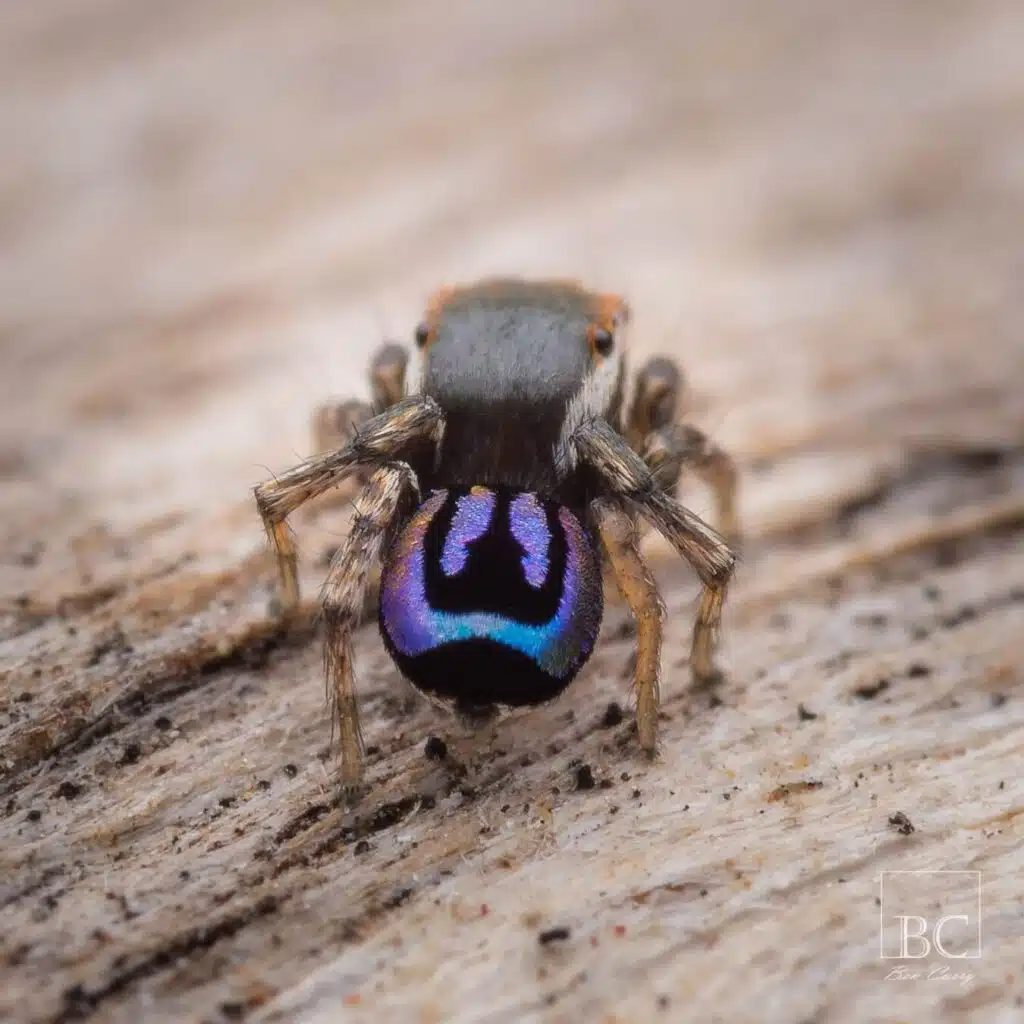
Scientific name: Maratus robinsoni
Common name: Robinson’s Peacock Spider
Another type of coastal spider, Robinson’s Peacock Spider can also have purple abdomens.
The male spider features a mostly black abdomen with highly contrasting purple-blue sections. These are U-shaped margins along the abdomen with additional purple stripes.
Its cephalothorax is completely differently-colored. It features a mostly brown color with a black gradient towards the abdomen.
Robinson’s Peacock Spiders also come in other iridescent abdomen colors which depend on the gender but which may also have a slightly different nuance depending on the viewing angle.
Green and yellow abdomen marks are also specific to this atypical spider.
Unlike The Coastal Peacock Spider, the male Robinson’s Peacock Spider’s abdomen is much less mobile. It’s still believed to be highly colorful and changing in abdomen color pattern as a means to attract a female mate.
Are Purple Spiders Poisonous?
While all spiders have venom, not all are considered medically significant in humans. The purple spiders are not dangerous to humans, though a bite can cause pain, swelling, redness, and urticating hairs on some purple tarantulas can cause significant skin irritation.
Purple Egg Sac – A New Spider Species in South Africa
A South African button/widow spider has been discovered with a scarlet exclamation mark on its back and white pattern, which has the shape of a human face. What is interesting is that these spiders lay bright purple eggs.
A team of scientists searched the area, finding more females with purple egg cases. Careful comparisons were concluded and the findings suggested a unique and new species which is unknown to humans and science.
Summary
Purple is not a common color when it comes to spiders, but the spiders listed above all have beautiful purple coloration. Some are popular in the pet trade for their vibrant colors, while others are easily identified in nature.
The good news is that none of the purple spiders are considered medically significant, though you should always proceed with caution when it comes to spiders, ensuring you do not provoke them.